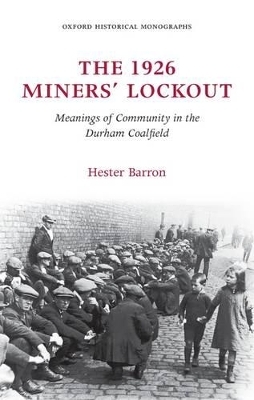
The 1926 Miners' Lockout
Meanings of Community in the Durham Coalfield
Seiten
2009
Oxford University Press (Verlag)
978-0-19-957504-6 (ISBN)
Oxford University Press (Verlag)
978-0-19-957504-6 (ISBN)
The miners' lockout of 1926 was a pivotal moment in British twentieth-century history. Investigating issues of collective identity and action, Hester Barron explores the way that the lockout was experienced by Durham's miners and their families, illuminating wider debates about solidarity and fragmentation within working-class communities.
The miners' lockout of 1926 was a pivotal moment in British twentieth-century history. Opening with the heady days of the general strike, it continued for seven months and affected one million miners. In County Durham, where almost three in every ten adult men worked in the coal industry, its impact was profound.
Hester Barron explores the way that the lockout was experienced by Durham's miners and their families. She investigates collective values and behaviour, focusing particularly on the tensions between identities based around class and occupation, and the rival identities that could cut across the creation of a cohesive community. Highlighting the continuing importance of differences due to gender, age, religion, poverty, and individual hopes and aspirations, she nevertheless finds that in 1926, despite such differences, the Durham coalfield continued to display the solidarity for which miners were famed.
In response, Barron argues that the very concept of the 'mining community' needs to be reassessed. Rather than consisting of an homogeneous occupational identity, she suggests that the essence of community lay in its ability to subsume and integrate other categories of identity. A collective consciousness was further grounded in a shared historical narrative that had to be continually reinforced.
It was the strength of such local solidarities that enabled both an exemplary regional response to the strike, and the ability to conceptualise such action within the wider framework of the national union. The 1926 Miners' Lockout provides crucial insights into issues of collective identity and collective action, illuminating wider debates about solidarity and fragmentation within working-class communities and cultures.
The miners' lockout of 1926 was a pivotal moment in British twentieth-century history. Opening with the heady days of the general strike, it continued for seven months and affected one million miners. In County Durham, where almost three in every ten adult men worked in the coal industry, its impact was profound.
Hester Barron explores the way that the lockout was experienced by Durham's miners and their families. She investigates collective values and behaviour, focusing particularly on the tensions between identities based around class and occupation, and the rival identities that could cut across the creation of a cohesive community. Highlighting the continuing importance of differences due to gender, age, religion, poverty, and individual hopes and aspirations, she nevertheless finds that in 1926, despite such differences, the Durham coalfield continued to display the solidarity for which miners were famed.
In response, Barron argues that the very concept of the 'mining community' needs to be reassessed. Rather than consisting of an homogeneous occupational identity, she suggests that the essence of community lay in its ability to subsume and integrate other categories of identity. A collective consciousness was further grounded in a shared historical narrative that had to be continually reinforced.
It was the strength of such local solidarities that enabled both an exemplary regional response to the strike, and the ability to conceptualise such action within the wider framework of the national union. The 1926 Miners' Lockout provides crucial insights into issues of collective identity and collective action, illuminating wider debates about solidarity and fragmentation within working-class communities and cultures.
Hester Barron is Lecturer in History at the University of Sussex. She studied at Magdalen College, Oxford and completed her D.Phil. in November 2006. Her research focuses on twentieth-century British social history, particularly labour history and the history of the working classes in the early part of the century.
Introduction ; 1. The Tensions of Class and Region ; 2. The Testing of Political and Union Loyalties ; 3. The Attitudes of Women ; 4. Religious Identities ; 5. The Influence of Education ; 6. Memory and Experience ; Conclusion
| Erscheint lt. Verlag | 10.12.2009 |
|---|---|
| Reihe/Serie | Oxford Historical Monographs |
| Zusatzinfo | 8 black and white halftones |
| Verlagsort | Oxford |
| Sprache | englisch |
| Maße | 145 x 223 mm |
| Gewicht | 574 g |
| Themenwelt | Geschichte ► Allgemeine Geschichte ► Neuzeit (bis 1918) |
| Geschichte ► Allgemeine Geschichte ► 1918 bis 1945 | |
| Geisteswissenschaften ► Geschichte ► Regional- / Ländergeschichte | |
| Geschichte ► Teilgebiete der Geschichte ► Kulturgeschichte | |
| Technik ► Bergbau | |
| Wirtschaft | |
| ISBN-10 | 0-19-957504-5 / 0199575045 |
| ISBN-13 | 978-0-19-957504-6 / 9780199575046 |
| Zustand | Neuware |
| Haben Sie eine Frage zum Produkt? |
Mehr entdecken
aus dem Bereich
aus dem Bereich
Europa 1848/49 und der Kampf für eine neue Welt
Buch | Hardcover (2023)
DVA (Verlag)
CHF 67,20
Giordano Bruno - ein ketzerisches Leben
Buch | Hardcover (2024)
C.H.Beck (Verlag)
CHF 41,85


